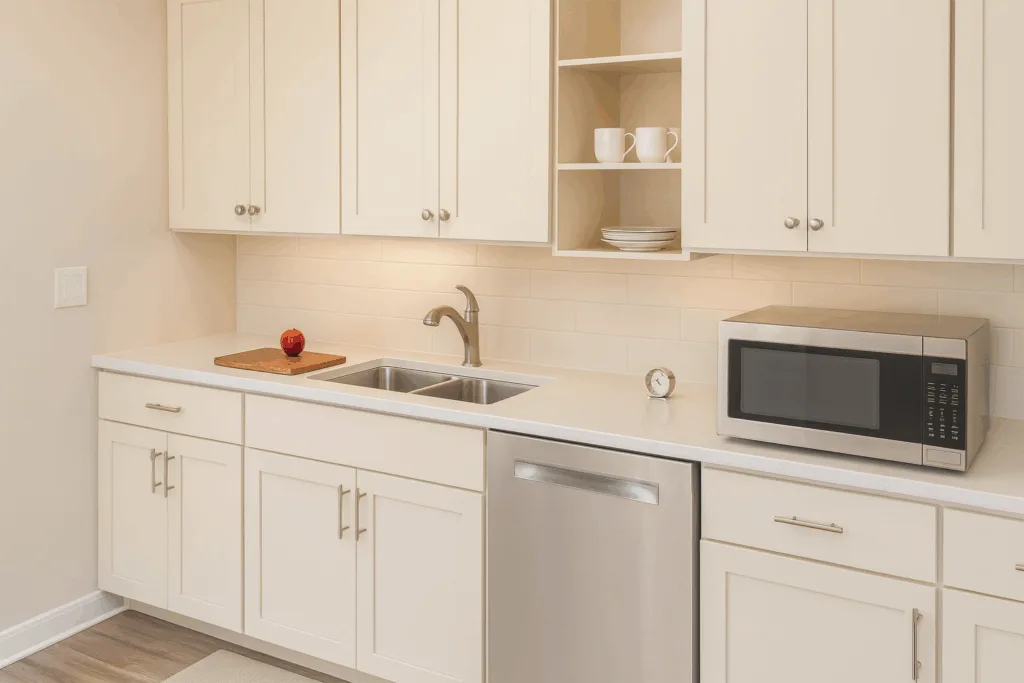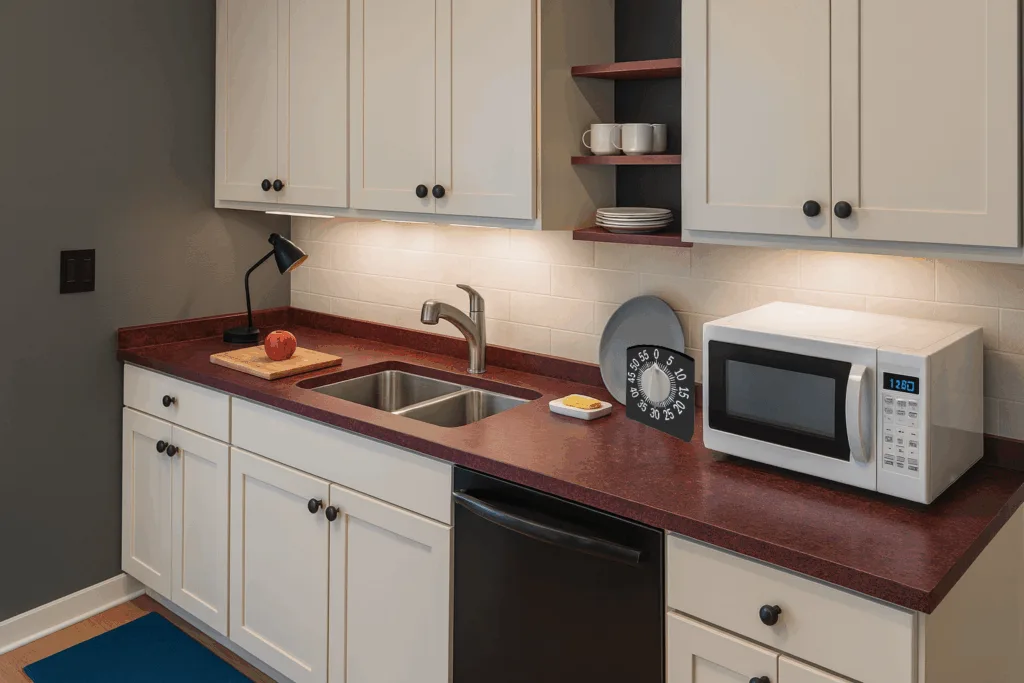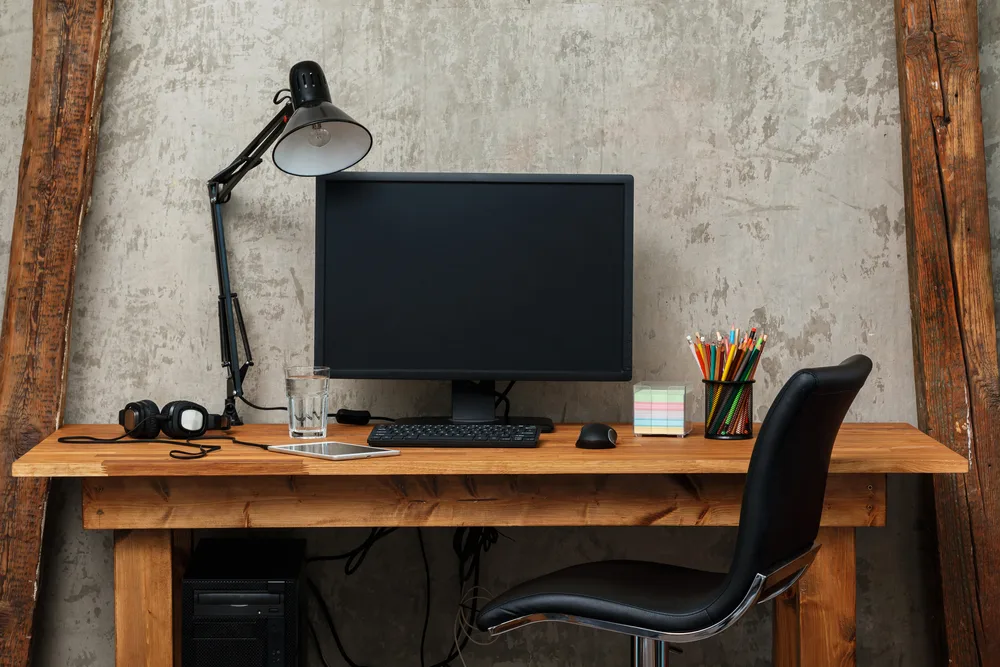Creating a Safe, Functional, and Comfortable Home with Low Vision
Your home should be a place of comfort, safety, and independence. For people who are blind or have low vision, thoughtful organization, lighting, and use of contrast can make every room more functional. Below are practical tips for the bedroom, closets, living room, kitchen, and home office.
Bedroom and Closets
The bedroom should be a place of rest and safety, but for someone with low vision, it can also present challenges such as tripping hazards or poor lighting. By making small adjustments in furniture placement, lighting, and organization, you can create a space that feels both comfortable and secure.
Ten Tips for Making Your Bedroom Safe, Functional, and Comfortable
- Arrange furniture to reduce obstructions in main traffic paths.
- Choose bedspreads, pillows, and window coverings with contrasting colors for easier identification.
- Use contrasting pulls on blinds to make them more visible.
- Select light switches and outlet covers that stand out from the wall color.
- Keep electrical cords, footstools, and other low objects out of walkways.
- Use adjustable blinds and coverings to control light and glare.
- Keep a magnifier or direct-light desk lamp at your bedside for reading or sewing.
- Position televisions to reduce glare.
- Store remotes in a tray or container that contrasts with its surroundings.
- Use a bedside lamp or nightlight for nighttime safety.
Note: Large-button telephones, large-print clocks, talking clocks, and low-vision alarm clocks are available. Many also include features for individuals with hearing loss.
Organizing Your Closet or Wardrobe
Closets can easily become overwhelming, especially if clothes and accessories are not organized in a way that makes sense visually or tactually. A few simple strategies can make it much easier to find what you need each day.
- Give away or throw away clothing you haven’t worn in over a year.
- Add dividers to drawers to separate items such as sweaters, scarves, and underwear.
- Organize by outfit, coordinating combinations in advance, or by color.
- Store small items like jewelry in plastic zipper-lock bags. You can also use bags to keep scarves and belts with specific outfits.
Living Room
The living room is often the hub of the home, where people gather, relax, and entertain. But it can also be a space filled with tripping hazards or poor lighting conditions. With some adjustments, you can make the living room both safe and welcoming.
Ten Simple Ideas for Creating a Safe, Welcoming Living Room
- Experiment with lighting to create a balanced, comfortable tone. Use window blinds to reduce glare and task lighting for reading and other activities.
- Remove clutter and extra furniture.
- Create 3-foot-wide clear paths for easy navigation. Repair carpet tears or floor irregularities.
- If you have a coffee table, consider one in contrasting color to the floor and one with rounded edges.
- Keep electrical cords out of pathways.
- Remove throw rugs if possible; if kept, secure them with nonskid padding or tape.
- Use color contrast throughout the room. For example, pillows should contrast with furniture, and furniture should contrast with the floor. Switch plates, outlets, and doorways should also be easy to distinguish.
- Position TVs, clocks, and other electronic displays away from glare.
- Keep small items, such as remotes, in designated trays or containers.
- Ask friends and family to respect your system of organization. Request that they return items to their place and not rearrange furniture without your input.
Kitchen
The kitchen is one of the most important—and most challenging—rooms to navigate with low vision. Preparing meals safely requires not only organization but also thoughtful use of color and tactile contrast. Below are two examples that show the difference contrast can make.
Low-Contrast Kitchen Example

- Light-colored cabinets with light-colored countertops and pulls.
- White plates on light shelves.
- Microwave blends into the surroundings and lacks tactile markings.
- Small timer with no tactile features or contrasting numerals.
- Dark cutting board with a dark apple—no clear contrast.
- Light switches blend into the light wall.
- Dishwasher the same color as adjacent cabinetry.
This setup makes it difficult to safely and efficiently prepare meals.
High-Contrast Kitchen Example

- Light cabinets paired with dark countertops and dark cabinet pulls.
- White plates stored on dark-colored shelves for easy visibility.
- Microwave with tactile markings stands out against the counter.
- Large timer with white numerals on a black background.
- Light cutting board used with a dark apple and a dark-handled knife for strong contrast.
- Light soap dish paired with dark soap.
- Light switches set against dark-colored walls.
- Dark dishwasher framed by light cabinetry.
This environment uses both visual and tactile contrast to make cooking and meal preparation easier and safer.
You can also learn Cooking Techniques for Blind and Low Vision Individuals to increase safety and accessibility in the kitchen.
Home Office
A home office should make it easy to focus on work without unnecessary frustration. By carefully choosing furniture, technology, and organizational systems, you can create a setup that’s efficient and tailored to your needs.

Ten Tips for Setting Up a Home Office
- Choose a space with ample lighting, and position furniture to minimize glare.
- Consider an L-shaped desk with a credenza for workspace and storage. Even in small spaces, a well-planned layout can be efficient.
- Select technology that meets your needs—such as a large monitor, screen magnification or screen-reading software, or an anti-glare screen.
- Mark your keyboard’s home keys, number pad, and on/off switches with raised dots or brightly colored puff paint.
- Use magnification tools, such as a video magnifier, handheld magnifiers, or spectacle-mounted options, for reading and correspondence.
- Keep active documents in a portable expanding file on your desk. Use labeled hanging folders in drawers for storage.
- Use bold-lined paper and bold-tipped pens, or try large print address books and smartphone contact lists.
- Mark important buttons on office equipment for easy use.
- Store supplies in consistent locations, and keep your most frequently used tools within reach.
- Adjust and experiment until your office setup feels efficient and comfortable for your needs.
Conclusion
A safe and functional home environment supports independence and comfort for individuals with low vision. By making thoughtful changes—such as using contrast, controlling glare, reducing clutter, and maintaining consistent organization—you can make each space in your homework better for you.
For more information, see: Lighting and Glare – VisionAware